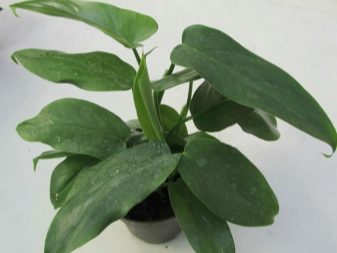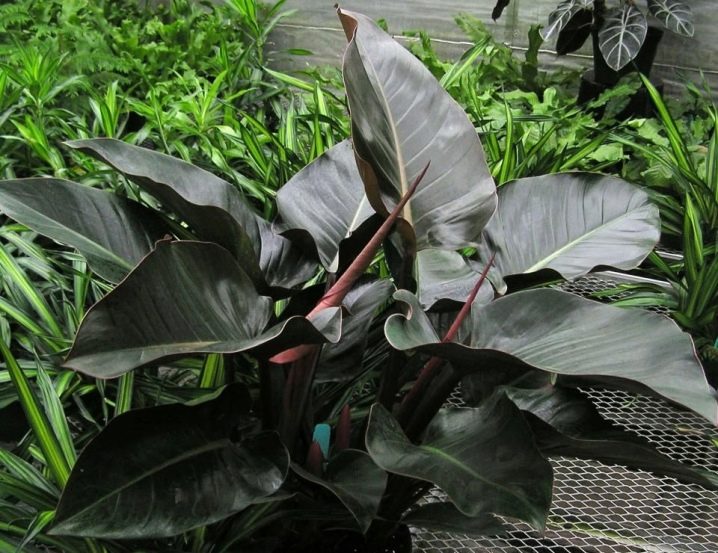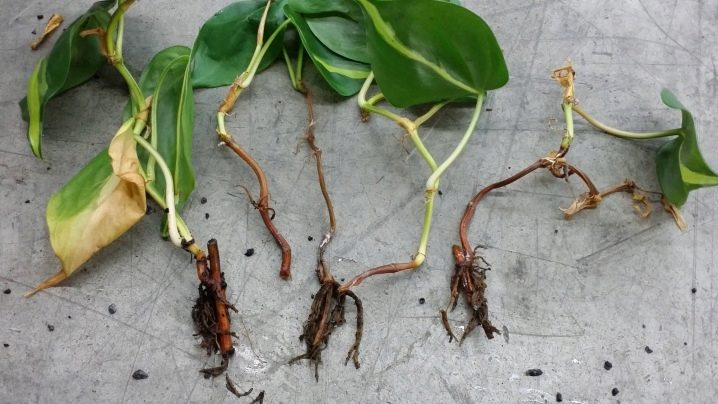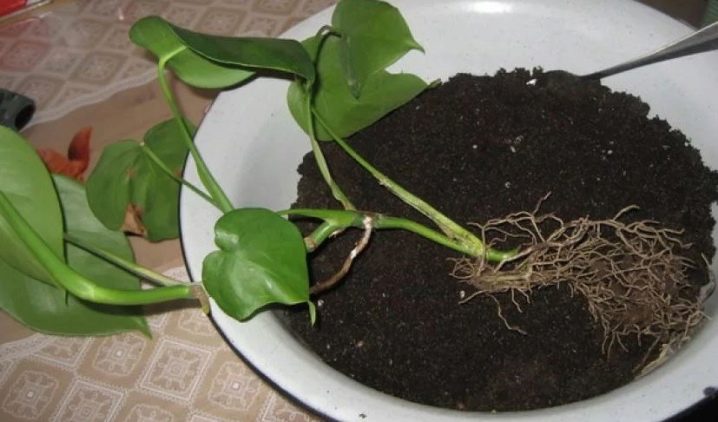Philodendron: types and care at home

Philodendron is an inhabitant of the tropical rainforests of Mexico and the southern United States. In nature, there are about 400 species of this ornamental deciduous plant, some of which have been successfully adapted for growing at home. Philodendron fits harmoniously into absolutely any interiors, adorns decorative arches, as well as green corners.

Description
The genus of philodendrons includes lianas, terrestrial and epiphytic forms, and a variety of dwarf shrubs. A distinctive feature of the culture is a branched root system, in most cases of a surface type. Philodendrons form aerial roots that absorb moisture and nutrients directly from the air. They can penetrate the bark and literally grow to the tree - thanks to this feature, they allow the philodendron to dig into the supports.


Its stems are rather thin, but at the same time long - up to 2-3 meters, the lower part begins to lignify with age. The leaf plates are quite large, their shape depends on the variety, as well as on the age of the plant - it can change over time. On the stems, cataphylls additionally grow - small leaf-scales that protect vegetative buds from unfavorable external factors.


There is an opinion that philodendrons are dangerous houseplants that should not be grown in residential premises. It is believed that this flower belongs to "muzhegons" and drives men out of the house and condemns its mistress to loneliness. In fairness, it should be noted that this opinion has no evidence and no scientific basis.
The version of its toxicity is closer to the truth - the fact is that the milky juice of this plant is poisonous and can cause irritation, an allergic reaction, up to Quincke's edema. To avoid such adverse consequences, all work on transplanting and pruning crops should be carried out with gloves and keep this plant out of the reach of small children and pets.


Bloom
In the natural environment, philodendrons belong to flowering crops. Their flowers outwardly are large cobs with multi-colored silk bedspreads in the shape of a hood. They come in pink, red, and purple or light green hues. In home gardening, the plant is cultivated for the sake of decorative foliage, since its flowers are rather inconspicuous, ugly and absolutely not attracting attention.
Inflorescences are located on shortened pedicels in groups or singly. Female flowers grow near the cob, male flowers on top. Their activity usually does not coincide in time, therefore, independent pollination at home is impossible to achieve. Artificial pollination requires several inflorescences in different phases of flowering, that is why it is possible to provoke pollination of a philodendron only in greenhouse conditions, where the habitat is as close to natural as possible.
In addition, several plants are usually grown there, so the probability of getting male and female flowers ripe for fertilization at the same time is quite high.


The flowering of the philodendron lasts only a day, so you need to act very quickly.After pollination, the ear is almost completely covered with a blanket and remains in this form until the fruits appear - they look like rounded small berries of a yellow, white or light green hue.
Plant varieties
The genus of philodendrons is one of the most numerous. In home floriculture, a variety of its types and varieties are grown. Let's dwell on the most popular ones. "Atom" is an extremely capricious variety to care for, which is a compact bush from the subspecies of lianas.
It differs in very beautiful, slightly curled leaves of a rich emerald tone, on each leaf plate there are 5 blades. It grows very slowly, so for home gardening, I usually shave an already mature plant. The scale-bearing species lives in America in its natural environment; it was first mentioned at the end of the 19th century. Refers to lianas, but does not occur on the surface of the earth, but it grows exclusively upward, clinging with the stem and side branches to all the trees standing nearby. Epiphyte.


At home, he loves porous soils. Leaves are elongated, juvenile. In young cultures, the plates are simple, but as they grow and develop, their shape becomes more complicated. The length of the leaf is about 45-50 cm, with age, the depth and the number of its lobes increase - in an adult plant there are already about 5 of them.
Warty is the most common subspecies of philodendrons., which is not surprising, because the plant is distinguished by its exceptional beauty and exotic appearance. This variety is referred to as evergreen vines, it has rather brittle stems. The leaf blades are heart-shaped, 15-20 cm long and about 8 cm wide. The stems are completely covered with villi. The creeping bedspread has a light amber shade, on the other hand it is burgundy. In most cases it is used for decorating winter gardens and greenhouses.
Requires well-humidified air; in a dry arid environment, it quickly dies.


The graceful subspecies are often called "skeleton" among the people. It was first described nearly 100 years ago after being discovered in the tropics of Colombia and Brazil. The leaves take the shape of a master key, visually resembling cut stripes that are planted quite deep. The length of an adult leaf plate is 45-55 cm, the leaves are asymmetric, they can often differ in the degree of irregularity, as well as in shape and size.
The stem is liana-like, with a large number of internodes. A similar liana looks like a blanket of bright emerald color, from the back it has a delicate crimson color. Prefers highly porous substrates, does not bloom in an artificial habitat.


"Cobra" is a variegated philodendron, which is distinguished by a special demand for the level of illumination and humidity, therefore it is most often bred in greenhouses. Blushing is a species of philodendron native to Brazil, also found on the ocean coasts of Costa Rica and Colombia. It got its name from a rather unusual appearance.
The fact is that leaf plates, young shoots, and also a stem have a reddish, almost crimson color. Refers to creeping vines. In nature, it grows up to 15-16 m, in room conditions - no higher than 2 m. The leaves are elongated, up to 30-45 cm in size, pointed at the ends. The sheet plate is flat, smooth, glossy.


Xanadu is a terrestrial tree species. For a long time it was believed that Australia was its homeland, but not so long ago, scientists proved that the plant originates from the Brazilian tropics. In the house it grows up to 1.5 m, the leaf plates are strongly dissected, very decorative, their size varies from 20 to 35 cm. In an artificial environment, there is almost no color.
It requires good illumination and high humidity - only under these conditions, the shade of the foliage becomes as saturated as possible.


"Climbing" philodendron - another liana, which tends to climb up due to adventitious branches and roots. Leaves are emerald in color, heart-shaped, slightly wrinkled, but their edge is solid.This green pet prefers partial shade. It is often used in indoor landscaping.


Medusa is a fast-growing philodendron. The foliage has a pronounced amber color, and the stem and cuttings are red. Needs good and bright lighting.


"Sello" is an evergreen lignified liana-like culture that grows up to 1.5 m. Its trunk is smooth, shiny, glossy. A characteristic feature of the variety is that traces of fallen leaves are visible on the trunk.
The plates are large - up to 100 cm, each has 10 lobes, cut rather deeply. The edges are slightly bent. The stop-shaped (lobular) philodendron is a fast-growing plant, it has large leaves ranging in size from 40 to 75 cm, their shade is dark green. The sheet plate is lacquered, glossy, has 5 pronounced lobe cuts. In the process of growing up, the number of kinks increases to 10.


Spear-shaped philodendron - liana with leaves of deep green color, has a rather thin barrel, therefore requires tying.


Philodendron Martius has rather short stems - no more than 30 cm, and in young vines they are completely absent. The leg is slightly lush, swollen, whole leaves, in the form of a heart. The width of the leaf plate is 20-25 cm and the length is about 50 cm.


Black and gold - a very exotic philodendron with a refined and rather fragile trunk. It grows in length by only 40-50 cm, but its leaf plates are much larger - up to 50 cm each. This is one of the varieties most demanded by flower growers.


Philodendron Ilseman is an exotic liana with a height of about 1-1.5 m. It has roots and requires good support. The length of an adult leaf plate is 40 cm, and its width is 10-15 cm. It does not have a uniform color, but on its surface there are pronounced spots of different sizes in a light green shade.

Decorated - A rather decorative philodendron with dark green leaves and textured whitish veins. The leaf plates of a young flower are ovoid. The parameters of the length and width of an adult leaf are 60 and 40 cm, respectively. The plant curls, requires support.

Also in home floriculture such varieties are in demand as "Skandens", "Mikans", "Radiant" and "Bipinnate" Philodendron, "Brasil", "Mediopikta", "Imperial Red", "Burle Marks", "Little Hope", " Goldie Lock, Imperial Green, Silver Queen, as well as Red Emerald, Lime Feed, Caramel Marble.
Conditions of detention
Philodendrons require comfortable living conditions for normal growth and development. In general, this is a very unpretentious culture that can even tolerate a short-term absence of the owners, but, nevertheless, you should know some of the intricacies of caring for it. If you decide to start a philodendron, the first thing you should understand is that as it grows, it will increase in size, and very noticeably, so it will need enough space.

Lighting
Philodendron is a native of the tropics and humid forests, so he prefers well-lit places, but so that the plant is reliably protected from bright ultraviolet rays. Light must certainly be diffused. Most varieties do not tolerate shading.
With a lack of light, the leaf plates become faded and elongated, which leads to the plant losing its decorative effect. It is better to place the philodendron on the east and west sides. If all windows in your house face south, then you will need light protection from the bright sun - this can be tulle, reflective film, or a small screen.


There was not enough lighting for the flower on the north side, so it is worth using artificial lighting here, especially in winter, when the daylight hours are rather short.
Temperature
A suitable temperature for the comfortable keeping of a philodendron is considered to be 18-24 degrees throughout the year. However, in the cold period, the heating level can be reduced to 14 degrees.If the room is colder, then the plant dies very quickly. In the summer, you need to use climatic equipment or at least ventilate the room as often as possible. For philodendrons, sharp and frequent temperature changes are fatal.

This tropical native places high demands on humidity. The optimal level for him is considered to be 70-75%. However, it may not "like" neighboring plants, and for people such a microclimate can be dangerous. Therefore, at home, the flower should be regularly sprayed with water from a spray bottle. It will not be superfluous to place a room fountain next to it, or at least a container with water.
A good solution would be to lay out the pallet. sphagnum moss.

The plant responds favorably to the neighborhood with the aquarium. Be sure to give your green pet a warm shower - dust interferes with air exchange and the plant will wither.
How to care?
At home, it is extremely important to engage in the formation of the crown of the philodendron. To do this, you need to carry out sanitary pruning, removing all dried leaves and branches. In addition, most philodendrons belong to long vines, therefore they need reliable supports. It is best to purchase a grill or racks for this. Only when growing in the vertical direction can the plant develop fully. All young leaves are replaced by adults, and the flower itself takes on an exclusively decorative look.

Top dressing
The plant responds very gratefully to feeding. Best to use ready-made store preparationswhich contain a set of essential minerals and nutrients. Top dressing is carried out weekly, but their concentration should be done 2-3 times lower than indicated in the instructions. From time to time, you can replace one of the dressings with organic ones. In winter, fertilization is not stopped, but they are carried out less often - once a month.

Watering
In nature, the rainy season is replaced by periods of drought, but even with these conditions, the air still remains quite humid, therefore, through its aerial roots, the philodendron can absorb moisture from the atmosphere. At home, it is impossible to achieve such environmental parameters, therefore, it is necessary to correctly establish the irrigation regime. It is extremely important not to allow the soil to dry out, since this primarily affects the size of the leaves.
You need to water the culture often and abundantly, but so that there is no waterlogging - in this case, the roots begin to rot and the plant dies very quickly.

Transplant and reproduction
Philodendrons propagate by seeds and vegetatively. The first method is the most troublesome and time-consuming, therefore, breeders most often resort to it to develop new varieties. The seeds of the crop are quite small, so they should be planted shallow - no more than 50 mm. The substrate should be used loose. For better water and air permeability, you can add a little pine needles to it. The reaction of the soil should be slightly acidic.
The seeds are planted in 5 cm increments, after which they are sprinkled with sand, watered with a drip method from a spray bottle and the container is covered with glass. Plastic wrap is also suitable for this.

After 1.5 months, the first shoots appear. As soon as 2-3 true leaves appear on the sprouts, a pick is carried out and seated in separate pots... The seedling of this tropical representative grows extremely slowly and at first has no external resemblance to an adult bush, only in the second year of life the leaf plates take on typical varietal outlines.
Philodendron can also be propagated by aerial roots. To do this, they are tilted into the ground, fixed and moistened so that they give roots. After that, you can carefully cut off the young shoot and transplant it into a separate container.

Philodendrons are also propagated by cuttings. For this, the apical shoots with 2-3 internodes are cut off and placed in water.To prevent decay, activated carbon is added to it or tinted with a solution of methylene blue. For accelerated root formation, you can add a little "Kornevin" to the water and create greenhouse conditions. For successful root growth, the vessel should be placed in a warm place at a heating level of 25-30 degrees.
Every two days, future plants should be ventilated, and the water should be changed once a week. Rooting usually lasts 2 to 4 weeks, after which the cuttings can be replanted to a permanent location.

Philodendron is bred with heel cuttings, meaning a leaf cut with a cuttings and a piece of old bark. The planting material is rooted in a peat-sand mixture, and as soon as the roots appear, they are transferred to a pot with a suitable substrate. Such a breeding method as layering is quite effective. To do this, a shallow incision is made on the side shoot, a stick or match is inserted, wrapped in wet moss and fixed with a film.
Moss needs to be moistened periodically. As a result, roots appear in a couple of weeks. The shoot is separated from the parent and transplanted into a permanent container. The roots will appear in 2-3 weeks.

Young plants require regular replanting - until they reach the age of 3-4 years, they must be moved annually to a larger pot with a renewed substrate. Adult philodendrons need replanting much less often - once every 3-4 years, the rest of the time you can do with replacing the topsoil. It is best to carry out these works in late winter - early spring.
But if you notice that the plant has stopped growing and began to wither, repot it at any other time.

It is very important to choose the right soil mixture, since the full growth of the flower largely depends on it. You can pick up a ready-made soil (a mixture made for orchids is suitable), or you can make a substrate yourself. Several options are possible here:
- 2 parts of sod land + 2 parts of coconut substrate + 2 parts of compost + 1 part of river sand;
- part of the finished soil for orchids + 2 parts of peat + 1 part of humus +1 part of coarse sand;
- 3 parts garden soil + 2 parts peat + 4 parts chopped bark + 1 part perlite, you can add a little horn shavings, bone meal and sand;
- 1 part compost + 1 part humus + 1 part coconut + 0.5 parts pine bark + 0.5 parts river sand.

Keep in mind that if you are self-collecting the components for the soil mixture, you need to additionally disinfect the finished soil - pour it with a weak solution of potassium permanganate or ignite it in the oven.
Philodendron does not tolerate waterlogging of the soil, so it needs good drainage. Expanded clay or large pebbles are poured onto the bottom of the pot so that this layer is at least a quarter of the entire volume of the container.

Diseases and pests
If the rules for caring for the plant are not followed development of the following problems is possible.
- The tips of the leaves dry up. This is a consequence of the lack of moisture in the air and soil, as well as drafts. To reanimate the plant, you should increase the frequency of spraying and rearrange the plant in a place protected from cold air masses, and also normalize the irrigation regime.
- If the edges of the leaf plates begin to brown, and the young leaves become smaller, there is an excess of moisture. In this situation, it is best to transplant the plant and temporarily limit watering.
- With a lack of light leaves become faded and lose their decorative effect. This requires artificial lighting or moving a pot with a vine to a more illuminated place.
- Curling the leaves becomes a consequence of an overabundance of fertilizers. In this situation, transplanting and temporary cessation of feeding helps.
- And here wishing and dropping the bottom leaves is a natural process, in this situation you do not need to do anything.



Like many other indoor plants, the philodendron is not uncommon to encounter insect pests.
- Shield located on the back of the leaf and on green stems. Visually, it can be identified by the appearance of small plaques. They destroy the parasite with a sponge dipped in soapy water; special insecticidal preparations are also highly effective.

- Aphid - small greenish insect. It feeds on the vital juices of the plant and at the same time multiplies quite quickly, turning into a colony in just a few weeks. If you do not pay attention to the problem in a timely manner, the plant may die. At the initial stage, treatment with soapy water will help, but if aphids have literally stuck to the green parts of the plant, then you should give preference to chemicals.

- Spider mite - such a small parasite that it is impossible to notice it with the naked eye, but its appearance can be judged by the whitish web, which is quite difficult to eliminate physically. It is best to use modern fungicidal preparations.

- Thrips Are small insects that live in the upper layers of the soil. From time to time, they crawl out and begin to feed on the green parts of the plant, after which the fox takes on a grayish-brown hue. To get rid of them, the flower should be treated with tobacco infusion and by all means transplanted with a complete replacement of the earthen coma, otherwise the struggle will not make any sense.

- Mealybug affects young leaves and young shoots. Its appearance can be judged by white cotton balls on the sheets, while they are not removed with soapy water. To save the plant, you need to wipe it with a sponge dipped in alcohol, and after half an hour, give the philodendron a warm shower.

Subject to the conditions for caring for a philodendron and creating comfortable conditions for its growth, it can become a real highlight of any interior. This tropical plant has long won the hearts of flower growers all over the world and has become one of the most popular indoor floriculture crops.
For information on how to properly care for a philodendron, see the next video.

























The comment was sent successfully.